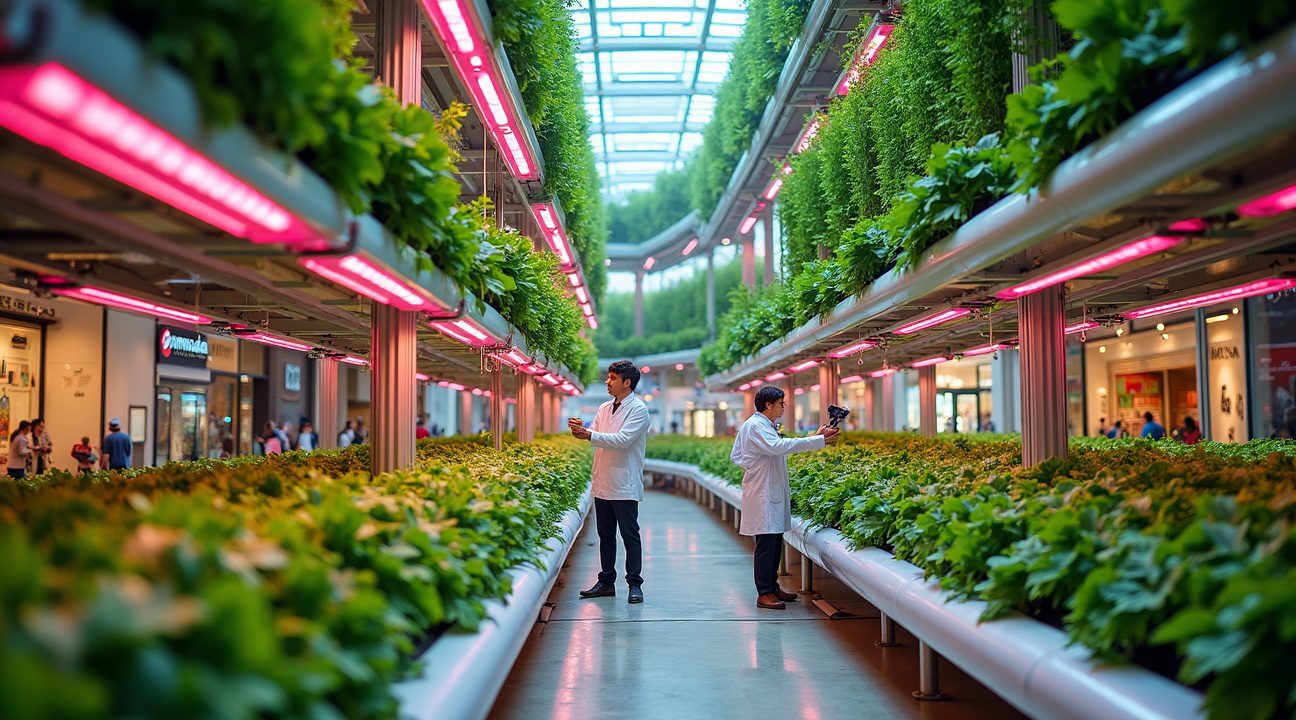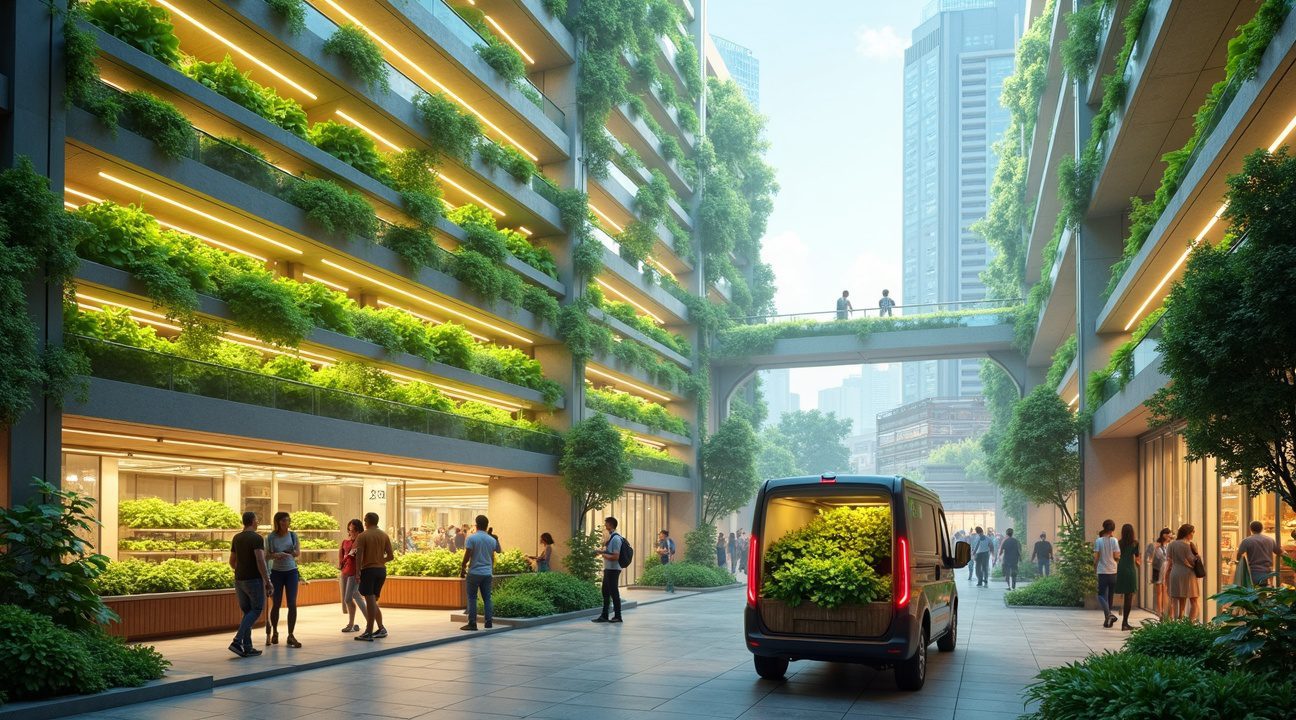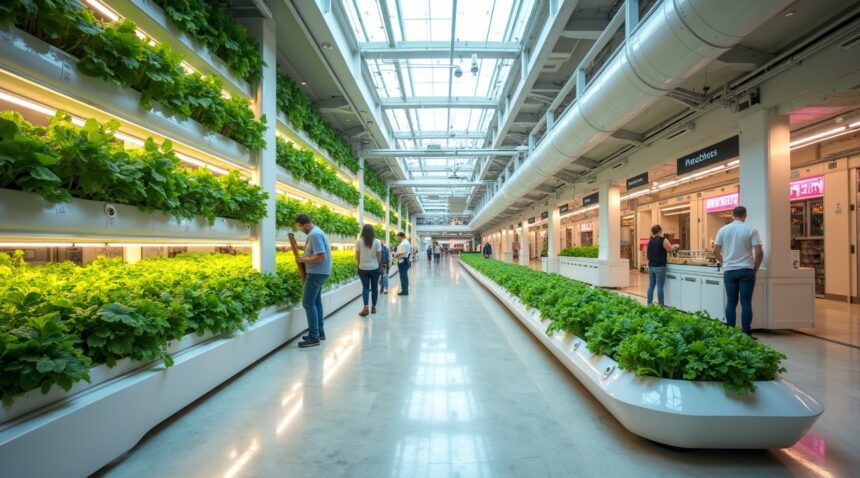Abandoned shopping malls across the United States present a remarkable solution to modern agricultural challenges, transforming once-bustling retail spaces into hubs of sustainable food production.
Key Takeaways
- Abandoned malls offer exceptional infrastructure for urban farming with established electrical systems, HVAC networks, and climate-controlled environments that would require millions in investment to construct from scratch.
- Indoor vertical farms consume 90% less water than conventional farming by utilizing hydroponic systems, while also producing crops close to urban centers, significantly reducing transportation-related emissions.
- These conversions create local job opportunities and contribute to economic rejuvenation in areas hit by retail closures—for example, Cleveland’s $1.1 million urban farming project provides agricultural training to local residents.
- Modern technologies such as LED lighting, automated climate control, and sensor-based nutrient delivery make year-round farming feasible while delivering greater yields per square foot compared to traditional agriculture.
- Success stories like Area 2 Farms in Arlington, Virginia showcase the potential of hyperlocal food systems. This initiative provides pesticide-free produce to nearby communities, eliminating spoilage due to weather and transport.
These repurposed malls not only bring communities closer to their food sources but also promote sustainability, job training, and technological innovation. Learn more about projects like Area 2 Farms that are redefining how and where we grow our food.
From Shopping Centers to Leafy Greens: America’s Mall-to-Farm Revolution
I’ve witnessed a remarkable transformation sweeping across America’s abandoned retail landscape. Over 1,000 shopping malls in the US now face closure or have already shuttered their doors permanently, creating unexpected opportunities for agricultural innovation. These vacant retail spaces are finding new life as cutting-edge indoor vertical farms, breathing fresh purpose into structures that once symbolized consumer culture.
The Perfect Space for Agricultural Innovation
Abandoned mall sites offer thousands of square feet of climate-controlled, protected space that’s ideally suited for crop production. I find these facilities particularly valuable because they already possess essential infrastructure – electrical systems, HVAC networks, and weatherproof enclosures that would cost millions to construct from scratch. The expansive floor plans that once accommodated department stores and food courts now house sophisticated growing operations.
These transformed retail spaces utilize hydroponic and aeroponic methods to cultivate produce like arugula, kale, and bok choy year-round. Indoor hydroponic systems eliminate dependency on soil quality and weather patterns, allowing farmers to maintain consistent harvests regardless of seasonal changes. Vertical farming techniques maximize space efficiency by stacking growing towers from floor to ceiling, dramatically increasing yield per square foot compared to traditional farming methods.
Technology Replacing Retail
The visual transformation is striking – shelves that once displayed consumer goods now support columns of leafy greens illuminated by specialized LED lighting systems. I’ve observed how these facilities incorporate advanced monitoring systems that track nutrient levels, pH balance, and moisture content with precision that surpasses traditional agriculture. Technology partnerships are driving innovation in this space, bringing automation and data analytics to urban agriculture.
Urban farms in repurposed malls address critical food security issues, particularly in food deserts where fresh produce access remains limited. These facilities can produce crops within miles of urban consumers, reducing transportation costs and environmental impact while delivering fresher products. Sustainability becomes a natural outcome when year-round production eliminates seasonal import dependencies and reduces carbon footprints associated with long-distance food transportation.
The economic benefits extend beyond agricultural output. These projects:
- Revitalize abandoned properties
- Create local employment opportunities
- Generate tax revenue for communities
I see developers increasingly attracted to mall-to-farm conversions because they offer stable, long-term tenancy compared to uncertain retail prospects.
Urban agriculture in former shopping centers represents more than creative space utilization – it demonstrates how communities can adapt infrastructure to meet evolving needs. Vertical farms produce significantly higher yields per square foot than traditional farming while using 95% less water through recirculating hydroponic systems. The controlled environment eliminates pesticide requirements and reduces crop loss from weather events or pest infestations.
Some facilities incorporate aquaponics systems that combine fish farming with plant cultivation, creating symbiotic growing environments where fish waste provides nutrients for crops. This integration maximizes resource efficiency while producing both protein and vegetables in the same space.
The mall-to-farm revolution reflects broader shifts in how Americans think about food production and urban planning. Bold innovations in agriculture are reshaping landscapes once dominated by consumer retail, proving that creative adaptation can solve multiple challenges simultaneously.
Success stories from converted facilities demonstrate the viability of this approach. Former anchor stores now house massive growing operations that supply local restaurants, grocery stores, and farmers markets with consistent, high-quality produce. The temperature-controlled environment that once kept shoppers comfortable now maintains optimal growing conditions for crops, showcasing how existing infrastructure can serve entirely different purposes with thoughtful planning and investment.

Cutting Transportation Miles and Environmental Impact
I find it remarkable that produce in the US travels an average of 1,500 miles from farm to plate, burning fossil fuels and generating emissions throughout the journey. Urban vertical farms housed in repurposed malls dramatically slash this distance to under 10 miles for local communities, creating a food system that operates more like a neighborhood market than a global supply chain.
Traditional agriculture contributes 6% of US greenhouse gas emissions, and this figure doesn’t even account for fertilizer production, pesticide manufacturing, or the long-haul transportation that moves crops across continents. When I examine the environmental footprint of mall-based urban farms, the contrast becomes striking. These hydroponic operations use up to 90% less water than conventional soil-based farming while often recycling nutrients and water in closed-loop systems.
Sustainable Systems Transforming Food Production
Mall-based vertical farms implement several key environmental advantages:
- Closed-loop hydroponic systems eliminate fertilizer runoff that typically contaminates waterways
- Minimal pesticide use reduces chemical contamination in surrounding environments
- Water recycling systems capture and reuse irrigation water multiple times
- Climate-controlled environments eliminate weather-related crop losses
- Year-round production maximizes food output per square foot
Many of these operations qualify for sustainability certifications such as the Moonganic Certification Spectrum, recognizing their reduced environmental impact compared to traditional farming methods. I’ve observed that reusing existing mall infrastructure minimizes construction waste while maximizing the utility of built environments that might otherwise deteriorate.
The water consumption differences prove particularly compelling. While conventional agriculture relies on weather patterns and often requires extensive irrigation, hydroponic systems deliver precise nutrient solutions directly to plant roots. This targeted approach eliminates water waste from evaporation, runoff, and over-irrigation that plague traditional field agriculture.
Pesticide reduction represents another significant advantage. Controlled indoor environments naturally limit pest infestations, reducing the need for chemical interventions that can harm beneficial insects and contaminate soil. When I compare this to conventional farming’s heavy reliance on pesticides and herbicides, the environmental benefits become clear.
These repurposed mall farms create local food security while addressing multiple environmental challenges simultaneously. They reduce transportation emissions, minimize water waste, eliminate agricultural runoff, and transform abandoned commercial spaces into productive green infrastructure. The model demonstrates how innovative thinking can turn economic challenges into environmental solutions, much like how cultural practices reshape public spaces or how strategic partnerships transform industries.

High-Tech Growing Systems Transform Retail Spaces
I’ve witnessed a remarkable transformation taking place in abandoned shopping centers across America, where cutting-edge agricultural technology breathes new life into empty retail spaces. These former department stores and anchor tenants now house sophisticated vertical farming operations that maximize food production within limited square footage.
Advanced Growing Technologies Replace Traditional Retail
Vertical farming systems stack multiple growing levels within the same footprint that once displayed merchandise, utilizing LED lighting arrays specifically tuned for optimal plant growth. These energy-efficient lights replace natural sunlight, providing consistent illumination 24/7 regardless of weather conditions or seasonal changes. Automated climate control systems maintain precise temperature and humidity levels throughout the facility, creating ideal growing conditions that traditional outdoor farming can’t match.
Sensor-based nutrient delivery systems monitor each plant’s needs in real-time, adjusting water and fertilizer distribution automatically. This precision agriculture approach eliminates guesswork and reduces waste while maximizing crop yields. I find it fascinating how these sensors can detect minute changes in soil moisture, pH levels, and nutrient concentrations, responding instantly to plant requirements.
Modular Systems Enable Rapid Scaling and Adaptation
Many urban farms operating in former malls employ modular growing systems that offer unprecedented flexibility for business expansion. These prefabricated units can be installed quickly within existing retail infrastructure, allowing entrepreneurs to start small and scale operations based on market demand. The modular approach also enables farmers to experiment with different crops and growing methods without committing to permanent installations.
Modern indoor farming encompasses several innovative techniques that work seamlessly within mall environments:
- Hydroponics: This eliminates soil entirely, growing plants in carefully balanced nutrient-rich water solutions that circulate through root systems. This method significantly reduces water usage compared to traditional farming while accelerating growth rates. Cultural innovations in agriculture often parallel developments in other industries, showing how communities adapt existing spaces for new purposes.
- Aeroponics: This technique takes soil-free growing further by suspending plant roots in air and misting them with nutrient solutions at regular intervals. It maximizes oxygen exposure to root systems, promoting faster growth and higher yields, especially valuable in space-constrained environments like malls.
- Closed-loop Recirculation Systems: These systems capture and reuse water and nutrients that would otherwise be lost. They filter and recycle growing solutions continuously, reducing operational costs while maintaining consistent crop quality.
Former anchor stores provide ideal conditions for these high-tech operations due to their large, open floor plans and existing electrical infrastructure. The absence of windows in many retail spaces actually benefits indoor farming by eliminating variables like changing natural light patterns and external temperature fluctuations. Climate-controlled environments allow year-round production cycles that generate consistent harvests regardless of external weather conditions.
These technological solutions address critical urban food security challenges while creating local employment opportunities in communities often hit hardest by retail closures. Partnership strategies between technology companies and agricultural innovators continue driving advancements in indoor farming systems.
The integration of artificial intelligence and machine learning algorithms further enhances growing efficiency by analyzing crop data and optimizing growing conditions automatically. These smart systems learn from each growing cycle, continuously improving yields and reducing resource consumption. I believe this combination of abandoned retail infrastructure and advanced agricultural technology represents a powerful solution for sustainable urban food production that addresses both economic revitalization and food security simultaneously.
Bringing Fresh Food to Food Deserts and Creating Jobs
I’ve seen abandoned shopping centers transform into powerful solutions for communities struggling with food access and economic opportunity. Many of these repurposed malls sit directly in urban areas classified as food deserts—neighborhoods where residents face significant barriers to accessing affordable, nutritious food options.
Cleveland’s approach demonstrates the potential impact of mall-to-farm conversions. The city funded a $1.1 million, three-year urban farming project that goes beyond simply growing food. This initiative trains local residents to cultivate and market produce, creating pathways for meaningful income generation in communities where the average household earns slightly over $9,500 per year. When I consider the economic landscape of these areas, this training represents more than agricultural education—it’s workforce development that addresses both food security and financial stability.
Community Benefits Beyond Fresh Produce
Studies on urban garden projects reveal that these spaces create multiple layers of community improvement:
- Urban farms increase neighborhood social cohesion by bringing residents together around shared goals
- Crime rates decrease in areas with active community gardens and farming initiatives
- Communal green spaces emerge where concrete and vacancy once dominated
- Local leadership skills develop as residents take ownership of food production
The transformation I observe in these communities extends far beyond the immediate benefits of fresh vegetables. Former mall spaces become accessible hubs for fresh food distribution, eliminating transportation barriers that often prevent low-income families from reaching distant grocery stores. These locations also foster local entrepreneurship as residents learn to market their produce and develop small-scale food businesses.
Repurposed shopping centers create natural gathering points for community events, farmer’s markets, and educational workshops. The large, climate-controlled spaces that once housed department stores now accommodate year-round growing operations, while former storefronts serve as processing areas, community kitchens, and meeting spaces. This infrastructure supports sustainable food systems that can operate regardless of weather conditions, much like how community initiatives in other contexts demonstrate the power of collective action.
The economic ripple effects extend throughout these neighborhoods. Local spending increases as residents purchase supplies, equipment, and services from nearby businesses. Job creation occurs not only in direct farming positions but also in supporting roles like equipment maintenance, transportation, and food processing. Young people gain exposure to agriculture and entrepreneurship, potentially sparking career interests they might never have discovered otherwise.
I notice that successful mall farming projects create momentum for additional community improvements. Property values stabilize as vacant eyesores become productive community assets. Other businesses show renewed interest in these areas, attracted by increased foot traffic and community engagement. The social capital built through collaborative farming efforts often translates into advocacy for other neighborhood improvements like better schools, safer streets, and improved public services.
These projects also address the skills gap in urban agriculture while building food system resilience. Residents learn not just how to grow food, but how to preserve it, prepare it nutritiously, and share knowledge with their neighbors. This knowledge transfer creates lasting change that persists even if specific farming projects evolve or relocate.
The success of mall farming initiatives depends on strong community partnerships between local government, nonprofit organizations, and residents themselves. Cleveland’s model shows how strategic public investment can leverage private resources and volunteer labor to create sustainable programs. When I examine these partnerships, I see that the most effective projects balance professional agricultural expertise with deep community knowledge and leadership.
These urban farming projects prove that abandoned commercial spaces can become catalysts for comprehensive community development. They address food access, create economic opportunities, build social connections, and transform physical environments simultaneously. The mall structures provide ideal conditions for this transformation—large spaces, existing infrastructure, and central locations that make fresh food accessible to entire neighborhoods.

Success Stories Across America
The transformation of abandoned retail spaces into productive agricultural ventures has gained momentum across the United States, with several pioneering projects demonstrating the viability of this innovative approach. These success stories provide concrete evidence that former commercial buildings can be reimagined as thriving food production centers.
Leading Examples of Mall-to-Farm Conversions
Several groundbreaking projects showcase how abandoned retail spaces can be converted into productive agricultural facilities:
- Area 2 Farms in Arlington, Virginia operates a cutting-edge vertical farm housed within a vacant commercial building, supplying fresh produce to customers within a 10-mile radius through on-site growing operations.
- Cleveland Urban Ag Project has secured $1.1 million in investment funding to train local residents in urban farming techniques across repurposed lots, with plans for future expansion into abandoned shopping centers if the initial phase proves successful.
- Multiple cities have begun exploring similar initiatives, recognizing the dual benefit of addressing food deserts while revitalizing economically distressed areas.
Area 2 Farms represents a particularly compelling model for this type of conversion. The facility demonstrates how controlled environment agriculture can thrive in former retail spaces, taking advantage of existing infrastructure like electrical systems and climate control capabilities. Their hyperlocal approach reduces transportation costs and ensures maximum freshness for consumers while creating jobs in underserved communities.
The Cleveland project takes a different but equally promising approach by focusing on workforce development and community engagement. This $1.1 million investment prioritizes training local residents in modern farming techniques, creating a skilled workforce that can eventually expand operations into larger abandoned retail facilities. The project’s success could serve as a blueprint for other Rust Belt cities facing similar challenges with vacant commercial properties.
These initiatives share common advantages that make them particularly suited for abandoned mall conversion. Former retail spaces often feature large, open floor plans ideal for farming equipment and growing systems. Many locations already possess the electrical infrastructure necessary for indoor agriculture, including three-phase power and adequate lighting capabilities. Additionally, former anchor stores provide the substantial square footage needed for commercial-scale food production.
The economic impact of these conversions extends beyond food production. Communities experiencing revitalization often see increased property values and renewed commercial interest in surrounding areas. Local restaurants and grocery stores benefit from access to ultra-fresh produce, while residents gain employment opportunities that don’t require extensive commuting.
Technology plays a crucial role in these success stories. Advanced hydroponic and aeroponic systems allow for year-round production regardless of climate conditions. LED lighting systems specifically designed for plant growth maximize efficiency while minimizing energy costs. Automated monitoring systems ensure optimal growing conditions while reducing labor requirements.
The Arlington facility’s focus on serving customers within a 10-mile radius highlights another key advantage of mall-based urban farms. This proximity to consumers dramatically reduces the time between harvest and consumption, resulting in superior product quality and extended shelf life. The model also supports sustainable distribution practices by minimizing transportation-related carbon emissions.
Financial sustainability remains a critical factor in these projects’ long-term success. The combination of reduced real estate costs for abandoned properties and premium pricing for locally-grown produce creates favorable economics. Many operations also benefit from government incentives designed to promote urban agriculture and community development.
The Cleveland project’s emphasis on resident training addresses a common challenge in urban agriculture: developing a skilled workforce. By investing in local talent development, the initiative creates a foundation for sustained growth and community ownership of the farming operations. This approach also ensures that economic benefits remain within the local community rather than flowing to outside investors or operators.
Obstacles and Future Potential
Converting abandoned shopping centers into agricultural spaces presents several challenges that developers and communities must address. Critics point out that urban farming typically produces less food per square foot compared to traditional rural industrial operations. However, I believe this criticism overlooks the significant environmental benefits these projects deliver, including reduced transportation distances and lower carbon footprints from farm-to-table distribution.
Financial and Market Challenges
The initial investment required to transform empty retail spaces into functional growing facilities can be substantial. Retrofitting these buildings involves installing specialized lighting systems, climate controls, hydroponic equipment, and proper ventilation — costs that can reach hundreds of thousands of dollars per facility. Market viability depends heavily on local community support and demand for locally-grown produce, which varies significantly across different regions and demographics.
Research and Development Initiatives
Current pilot projects across the country are focusing on several key areas to improve the economics of mall-based farming. These initiatives include:
- Developing more energy-efficient LED lighting systems that reduce operational costs
- Creating automated growing systems that minimize labor requirements
- Testing vertical farming techniques that maximize space utilization
- Establishing partnerships with local restaurants and grocery stores for guaranteed sales channels
- Implementing community-supported agriculture programs to ensure steady revenue streams
Research institutions are also studying optimal crop selection for indoor environments, focusing on high-value vegetables and herbs that command premium prices in local markets. Some projects are exploring cultural integration approaches similar to successful community initiatives in other sectors.
Advanced growing technologies continue to evolve, with newer systems promising higher yields and lower energy consumption. Smart sensors and artificial intelligence are being integrated to optimize growing conditions automatically, reducing the need for specialized agricultural knowledge among operators. These technological advances could make urban farming more accessible to communities without extensive agricultural backgrounds.
The future potential extends beyond simple food production. Some facilities are incorporating educational components, offering tours and classes that connect urban residents with food production processes. Others are exploring innovative partnerships that combine retail sales with on-site growing operations.
Economic models are also evolving to address profitability concerns. Mixed-use approaches that combine farming with other revenue-generating activities like event hosting, farmers markets, or food processing are showing promise. Grant funding from government agencies and private foundations continues to support these experimental projects, helping to prove their viability before requiring full private investment.
Sources:
Moonganic – “Mall to Meal: Urban Farming in Retail Ruins”
Audubon Magazine – “Urban Farms Sprout Across the Country”
Context/Thomson Reuters Foundation – “In the US, urban farmers use empty buildings for growing crops”
YouTube – “Flipping Abandoned Lots Into Urban Farms!”


